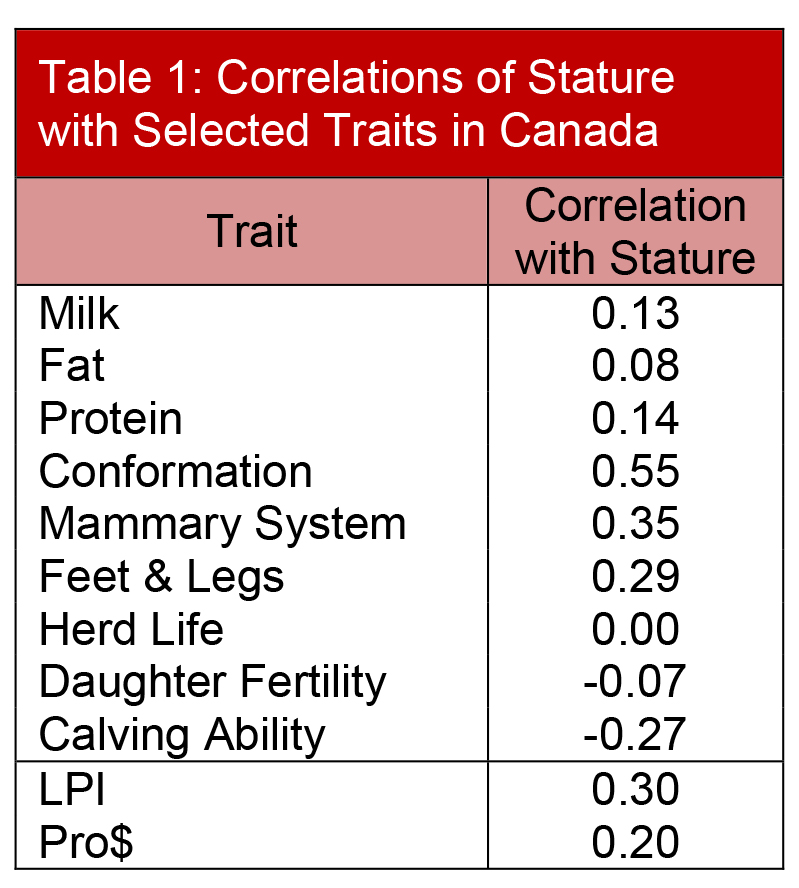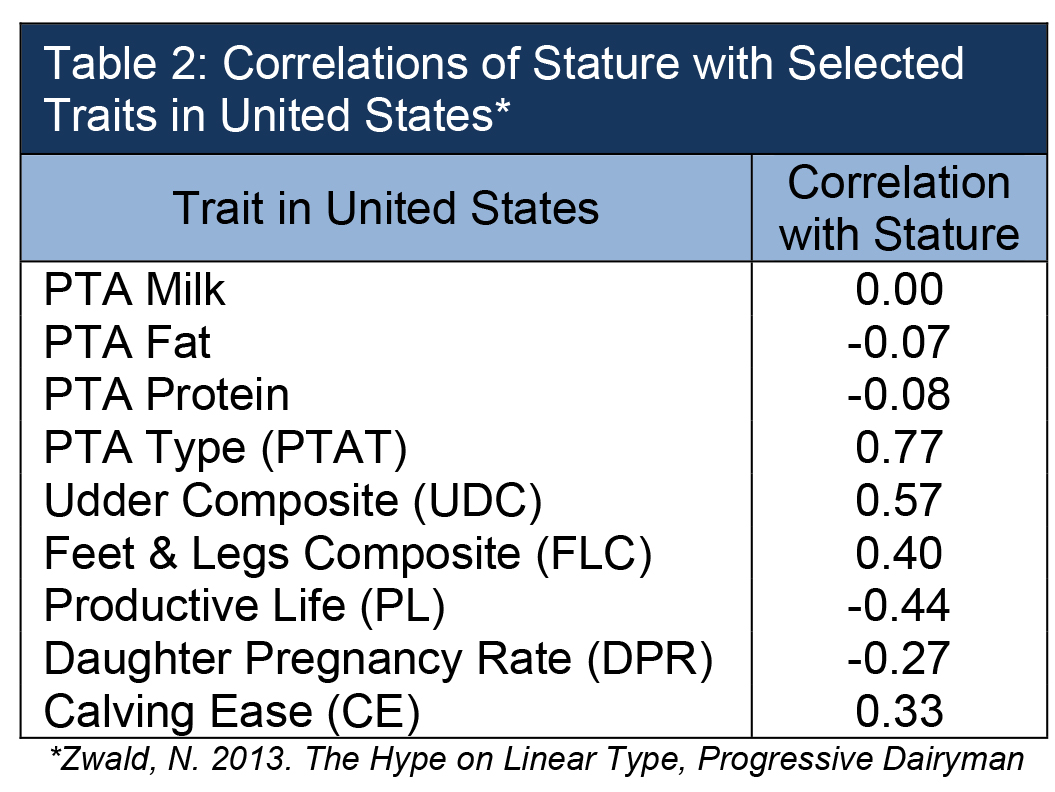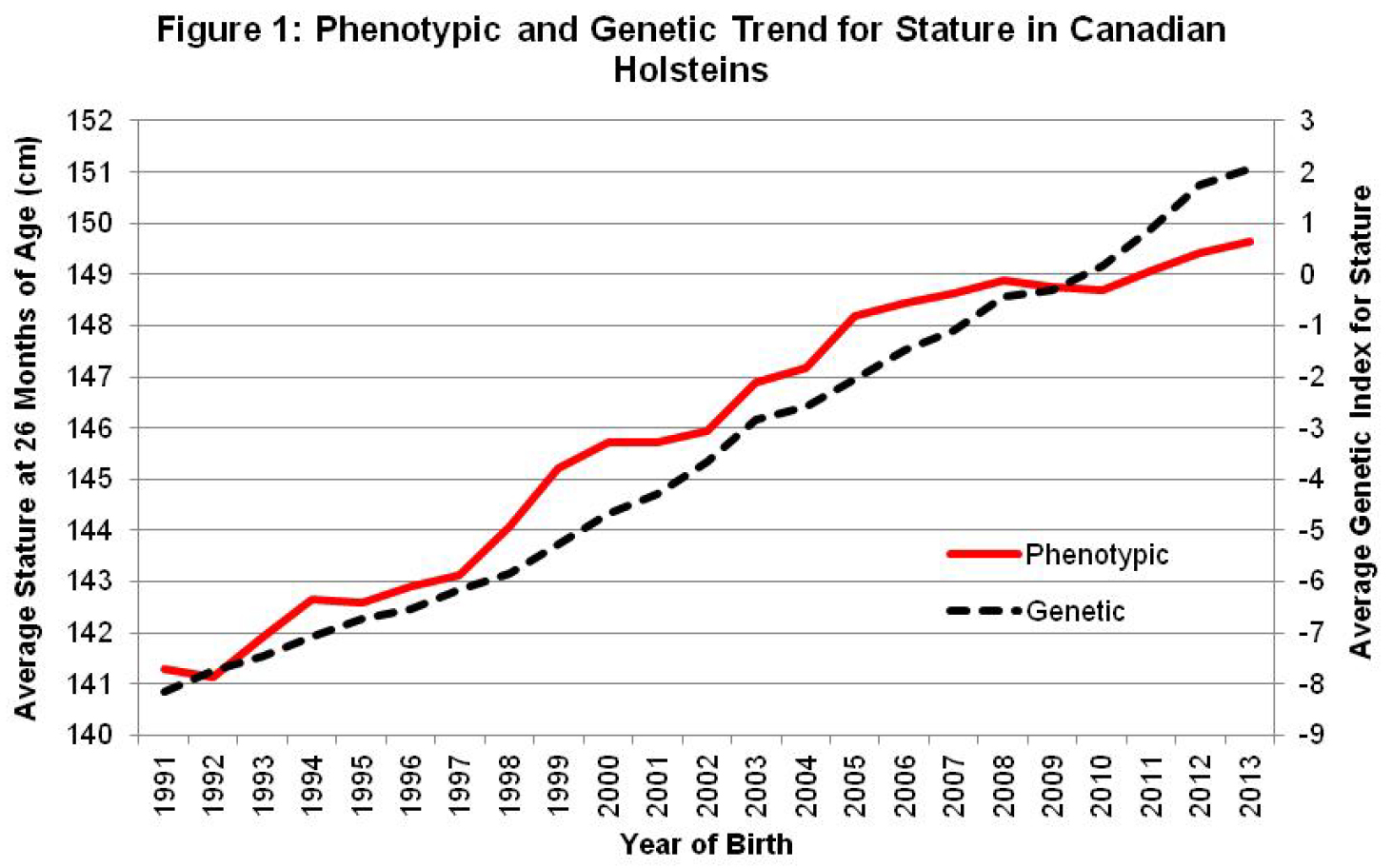There’s no doubt in anyone’s mind, Holsteins are getting bigger. Problems related to larger animals can include higher maintenance, more injury, issues fitting in existing stalls, increased calving difficulties and more. Let’s take a look at stature trends, breed goals and trait correlations to gain a better understanding of the impact of taller cows.
How is Stature Measured and How are Proofs Calculated?
For many decades, Holstein Canada has been using a type classification system that includes stature. Since 1993, this trait is one of those that are measured objectively and stature is defined as the height of the cow at her hips. In the Classification report left on farm, measured stature is converted and expressed on a 9-point linear scale used for descriptive type traits. These values are adjusted for the cow’s age at calving as well as her stage of lactation. Cows receiving a linear score of 6, 7 or 8 receive the highest credit in terms of contributing to the overall score for Dairy Strength while a score of 9 actually contributes less. The same linear scale ratings from 1 to 9 are used as input into the genetic evaluation system for calculating bull proofs and cow indexes for each trait.
As is the case with all type traits, sires of daughters with average stature have a genetic evaluation of 0 for the trait. Bulls expected to sire taller than average daughters have a proof greater than 0, while bulls that sire daughters expected to be shorter than average have a proof less than 0. Given the genetic relationship between stature and other type traits, it is relatively rare to see a high ranking sire for either national index, LPI or Pro$, that has a negative proof for stature.
Evolution of Breed Goals
Over time, breed goals change once landmarks are achieved, new traits are added or the needs of the industry evolve. One clear example of this is selection for Daughter Fertility, a trait that only became relevant in the early 2000’s after decades of heavy selection for production, which took a negative toll on breed fertility. Over the years, Holstein Canada’s type classification system has also shifted focus, gradually reducing the emphasis of stature’s contribution to Dairy Strength, and as a result, to overall Final Score. After various changes over the years to the conformation assessment program offered by Holstein Canada, stature currently contributes only 2.4% of a cow’s Final Score, noting that linear scores of 6 to 8 are considered ideal.
Stature Trends
Figure 1 shows the genetic and phenotypic trends in stature for Holstein cows born since 1991. The genetic trend for stature has been quite steady at nearly one EBV point every two years. In terms of interpreting sire proofs for Stature, every 5 point increase in proof translates to almost a centimeter taller in terms of the average stature of their daughters. The phenotypic trend is based only on cows classified at 26 months of age to demonstrate the increase in average stature over time for a fixed age. This trend shows that Holsteins gained, on average, over half a centimeter (i.e.: 0.20 inches) in height per year from 1991 to 2005. Since the implementation of the Multi-Breeds Classification Program and the associated changes, in 2005, this trend has slowed down significantly, averaging 0.18 cm (i.e.: 0.07 inches) per year. This slower increase in average stature is likely a reflection of the revised objectives of the conformation assessment program and is also influenced by A.I. usage of certain bloodlines and more consistent heifer rearing over time.
Stature’s Relationship with Other Traits

Correlation results between stature and selected traits in United States (Table 2) aren’t always consistent with those seen in Canada. In the US, stature has a stronger positive correlation with major type traits, particularly PTA Type. Even more importantly, stature is negatively correlated with Productive Life and Daughter Pregnancy Rate meaning that taller cows have poorer longevity and fertility. In both Canada and the US, stature has an undesirable relationship with calving ease, with larger calves leading to significantly more difficult births.

The Future of Body Size Traits
Individual herds may warrant more concern about stature, especially if cows aren’t fitting in existing stalls or parlours. In terms of breed goals, stature should be considered for corrective mating rather than striving for continued genetic and/or phenotypic increases. Due to stature’s correlation with other important traits, such as Mammary System, it will likely continue to slowly increase over time. In the future, you can expect stature will evolve to reflect economically important traits related to cow size like feed efficiency and methane emissions, which are expected be available for selection in coming years.












